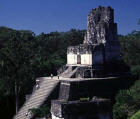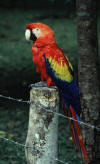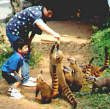The steamy hot jungles of the eastern Guatemala lowlands hide evidence of a vast Mayan civilization that prospered around 700 AD. Archaeologists exploring the region excavated forest-clad mounds that led to the discovery of a complex network of ancient cities.
Topoxte, Yaxhá, Nakún, Uaxatún, El Mirador and many more – but the most spectacular of all is Tikal, with its five skyscraper-like temples poking above the forest canopy. The highest, at 65 metres, is the Temple of the Two Headed Snake (Temple IV), which was built by King Yaxkin Caan Chac around 470 AD.
The base of the pyramid is a tangle of trees and vines with wooden steps leading steeply upward. At the halfway terrace is an entrance to a tomb. It is a welcome breathing spot and viewpoint over the forest. A steady stream of tourists from all over the world, young and old, bodies dripping with perspiration, pause to rest. Panting, they admire the view, study their guide book and take photographs before continuing upwards.
The final 8 metres is up a vertical iron ladder to access the summit ledge. I hesitate. Will I or won’t I? Resting awhile to gather breath and confidence, I watch tourist bottoms disappear successfully upwards. Others give one look and shake their heads – “Not for me,” they say. Really, the Maya have a lot to answer for – no thought for the well-being of tourists 1300 years later. I pluck up courage and ascend rung by rung, to burst forth onto the topmost ledge. Wow! What a view!
|
![]() Jungle tops stretch to the horizon, punctuated by the summits of four stone temples. Some 700 metres distant is the Great Plaza, where the ruler Ah Cacao, alias King Chocolate, built the Temple of the Masks (Temple II) and the Temple of the Great Jaguar (Temple I), his burial site, ca 700 AD.
Jungle tops stretch to the horizon, punctuated by the summits of four stone temples. Some 700 metres distant is the Great Plaza, where the ruler Ah Cacao, alias King Chocolate, built the Temple of the Masks (Temple II) and the Temple of the Great Jaguar (Temple I), his burial site, ca 700 AD.
At ground level the tourists picnic under rustic shelters, sharing tidbits with the multi-hued ocellated turkey. Howler monkeys, shy of humans, swing in tree tops. Black vultures glide overhead and gather to roost on top of the Temple of the Great Jaguar.
Fascinating are the leaf cutter ants. These industrious creatures have a special tree from which they cut up leaves into tiny pieces and carry them to their den maybe fifty metres distant. A busy column of ants, coming and going, suggests how the Maya built these huge stone cities.
Tikal lies 71 km NE of Flores, the capital of El Petén Province. Flores is a tidy Spanish colonial village crowded onto an island hill in Lake Petén Itzá. It is connected to the mainland and the seedy town of Santa Elena by a half kilometre causeway. Santa Elena is a scary wreck of a place having unsealed streets frequented by roaming cattle, pigs and chickens. Walk across the causeway and you enter a new world – Flores the tourist town, with sealed streets, colonial buildings, craft shops, economical hotels and hospedajes, dinky cafés and restaurants with lakeside views.
|
![]() There is much to see and do in Flores. It is a good place to linger and relax. The “El Tucán” restaurant on the lakeshore is a great place but watch out for the bird-life! Their pet Macaw parrot will insist on his share of your meal, and if he gets close enough will crunch to pieces any shirt button or ear-ring!
There is much to see and do in Flores. It is a good place to linger and relax. The “El Tucán” restaurant on the lakeshore is a great place but watch out for the bird-life! Their pet Macaw parrot will insist on his share of your meal, and if he gets close enough will crunch to pieces any shirt button or ear-ring!
You can cruise the lake in a motorised dugout canoe, visit lakeside villages and a zoo, or go fishing for bass. The hilltop plaza houses the cathedral and a tourist information office.
A daily minibus service operates between Flores and Tikal with pickup at Flores hotels for US$7 return. Entrance fee to the National Park is US$10. Leaving at 6 am, you arrive by 7:30 am ready for breakfast at the rustic Gran Jaguar restaurant near the park entrance.
Early morning mists make the 1 km jungle walk to the first temple somewhat eerie. The jungle is as fascinating as the ruins. Fat-trunked ceiba trees and Spanish cedar bedecked with epiphytes and orchids, once provided timbers for houses and canoes. Spices and fruits abound and were used by the Maya, including pimiento and chicle, the source of chewing gum.
Grassy glades extend around the Great Plaza, the centre of the ancient city of Tikal. What a magnificent spot! East and west of the plaza are the Temples of the Gran Jaguar and The Masks, while to the north lies the sprawling Acropolis.
|
![]() By midday the ruins are alive with tourists. The heat is stifling as the sun reflects off the white limestone walls and paths. I escape the blistering heat of the plaza by strolling the cool jungle paths – animals scamper here and there – the pizote or coatimundi, the rat-like capybara, and foxes do their thing.
By midday the ruins are alive with tourists. The heat is stifling as the sun reflects off the white limestone walls and paths. I escape the blistering heat of the plaza by strolling the cool jungle paths – animals scamper here and there – the pizote or coatimundi, the rat-like capybara, and foxes do their thing.
Being surrounded by jungle makes Tikal so different from the other famous Mayan sites of Uxmal and Chitchén Itzá in the Yucatán.
Tikal was an important Mayan settlement for over 1500 years, starting about 700 BC. During the Classic Period 300 – 900 AD, the city prospered through trade and military conquest when the population peaked at 100,000. This period began with King Yax Moch Xoc, followed by King Great Jaguar Paw, Lord Water, General Smoking Frog, Lord Chocolate all playing their part. Lord Chocolate (682-734 AD) was the 26th successor to the throne after Yax Moch Xoc and he and others were responsible for building the two temples on the great plaza.
This civilization suffered a mysterious collapse after 900 AD when the cities became deserted and the jungle took over. Remnant Maya settled around Lake Petén Itzá and on the island now occupied by Flores. Their island village of Tayasal was captured by the Spanish in 1697.
The lost world of the Maya was rediscovered by European explorers in the 1840’s and it rapidly became a focus for archeological research which is continuing today. The tourist boom is a comparatively recent phenomenon. Today the 576 sq km Tikal National Park with its thousands of preserved stone structures is there for all to explore and enjoy.
Fast Facts
Once one of the greatest cities in the world, Tikal in its heyday ca 700 AD, was the capital of a vast Mayan empire. Today, the site is one of Guatemala‘s premier tourist attractions. Its unspoiled jungle setting makes it special for discerning travellers, particularly naturalists and bird watchers.
Getting There
The well-to-do traveller flies in/out to Flores and stays at the more upmarket hotels.
The budget traveller can bus in to Flores from Chetumal, Mexico (direct), or from Belize City; bus from Guatemala City is an adventure and tedious – better to fly in 30 minutes!
Plane Fares
Guatemala City – Flores; 6:30 am & 9:30 am, US$87/115 single/return.
Belize City – Flores; 8 am & 2:30 pm, US$96/172 single/return.
All in one day, 5 am to 5 pm, $US180
Two days and one night, US$225, stay in hotel at Flores or Tikal.
Bus Fares
Check Lonely Planet Guide for bus details.
Tikal National Park has only limited accommodation so most people stay elsewhere, e.g. the island town of Flores and adjacent Santa Elena, or at El Remate, halfway between Flores and Tikal.
Accommodation
The village of El Remate at the east end of Lake Petén Itzá is a favorite spot with many options. Fanciest is the Hotel Camino Real Tikal on the lake shore with all amenities, including private yacht for guests. Cost ca US$180 double.
For economical bungalow accommodation and camping try El Mirador del Duende, also La Casa de Don David (David’s Hotel) US$20 double with economical restaurant. Bus to Tikal US$4.
At Tikal, within walking distance of the park, is the famed Jungle Lodge, but always booked out (years ahead) by tour groups; ditto The Jaguar Inn and Tikal Inn closeby, are all in the $50/night bracket.
The budget traveller may arrive by bus after dark in Santa Elena. Lonely Planet lists half a dozen “el cheapo” hotels here (US$3/night). OK for o’nite, but at day break hi-tail it across the causeway to Flores and find a nice hospedaje. Recommended are Hospedaje Doña Gogal and Posada Tayazal, both ca Q50/night, on far side of island, plus many more.
Caution
Cuidado! Robbing tourists is a favorite pastime in Guatemala (& elsewhere in Central America). Be alert 100% of the time. Take usual precautions against sneak thieves (often children) and pickpockets at bus terminals, on the bus, post offices, ATMs, mercados, restaurants etc. Tie and padlock everything. Keep off the streets at night-time. Buena suerte!
Climate
Tropical and humid. Hat, sunglasses and sun block cream required. Hottest month is April. Rainy season: May to October. Check the weather report for Flores now.
Exchange Rate
US$1 = 8.7 Guatemalan Quetzales, but check the rate today.
Banks in Santa Elena and Flores give cash advances for VISA.
The Author

You can visit Allano’s web site by clicking here.


